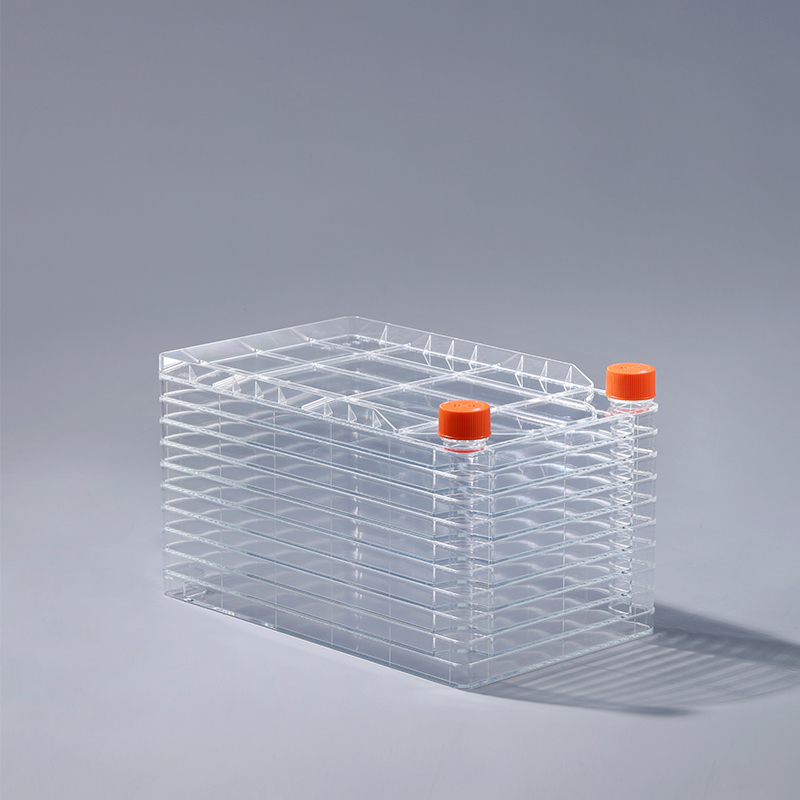هو جهاز زراعة الخلايا ، والذي يتكون من طبقة واحدة أو أكثر وفقًا لحجم منطقة الاستزراع ، والتي يمكن أن تدرك الثقافة الواسعة للخلايا ، وهي مناسبة للعديد من المجالات مثل اللقاحات وصناعة الأدوية أو جسم مضاد لاستنساخ المونومر. يمكن لمصنع الخلية أن يلبي زراعة الخلايا الملتصقة ، كما أنه مناسب أيضًا للثقافة الثابتة للخلايا المعلقة. تعني الثقافة الملتصقة أنه يجب ربط الخلايا بجدار وعاء الثقافة (الزجاجة) عندما يتم تربيتها. بمجرد توصيل الخلايا ، ستنتشر بسرعة ، ثم تبدأ الانقسام ، وتدخل بسرعة في مرحلة النمو اللوغاريتمي. بشكل عام بعد بضعة أيام ، يتم تغطية سطح المزرعة وتشكيل طبقة أحادية الخلية كثيفة ، مثل خلايا Vero ، وخلايا HEK 293 ، وخلايا CAR-T ، و MRC5 ، وخلايا CEF ، والضامة السنخية الخنازير ، وخلايا المايلوما ، وخلايا DF-1 ، تتبنى جميع الخلايا ST ، وخلايا PK15 ، وخلايا Marc145 ، وما إلى ذلك طرق زراعة ملتصقة. لا يعتمد نمو الخلايا المعلقة على سطح الدعم ، وتنمو في حالة تعليق في وسط الثقافة. على سبيل المثال ، يتم استخدام خلايا CHO وخلايا الحشرات وخلايا BHK21 وخلايا MDCK في ثقافة التعليق. cell factory
يستخدم مصنع الخلايا مزايا الهيكل متعدد الطبقات والمساحة الكبيرة ، ويستخدم على نطاق واسع في الإنتاج الضخم الصناعي لتلبية الاحتياجات المزدوجة للثقافة الملتصقة وثقافة التعليق ، ويفضلها العديد من مؤسسات البحث العلمي وشركات الأدوية.
Suspension culture refers to a tissue culture system that cultivates single cells and small cell clusters in a liquid medium that is constantly agitated or shaken. The growth of suspended cells does not depend on the surface of the support, and grows in a suspended state in the culture medium. For example, CHO cells, insect cells, BHK21 cells and MDCK cells are all used in suspension culture.
The cell factory utilizes the advantages of multi-layer structure and large area, and is widely used in industrial mass production to meet the dual needs of adherent culture and suspension culture, and is favored by many scientific research institutions and pharmaceutical companies.
The FAI climbed 5.9 percent year-on-year in the first 11 months of 2018, quickening from the 5.7-percent growth in Jan-Oct, the National Bureau of Statistics (NBS) said Friday in an online statement.
The key indicator of investment, dubbed a major growth driver, hit the bottom in August and has since started to rebound steadily.
In the face of emerging economic challenges home and abroad, China has stepped up efforts to stabilize investment, in particular rolling out measures to motivate private investors and channel funds into infrastructure.
Friday's data showed private investment, accounting for more than 60 percent of the total FAI, expanded by a brisk 8.7 percent.
NBS spokesperson Mao Shengyong said funds into weak economic links registered rapid increases as investment in environmental protection and agriculture jumped 42 percent and 12.5 percent respectively, much faster than the average.
In breakdown, investment in high-tech and equipment manufacturing remained vigorous with 16.1-percent and 11.6-percent increases respectively in the first 11 months. Infrastructure investment gained 3.7 percent, staying flat. Investment in property development rose 9.7 percent, also unchanged.
 English
English



















































